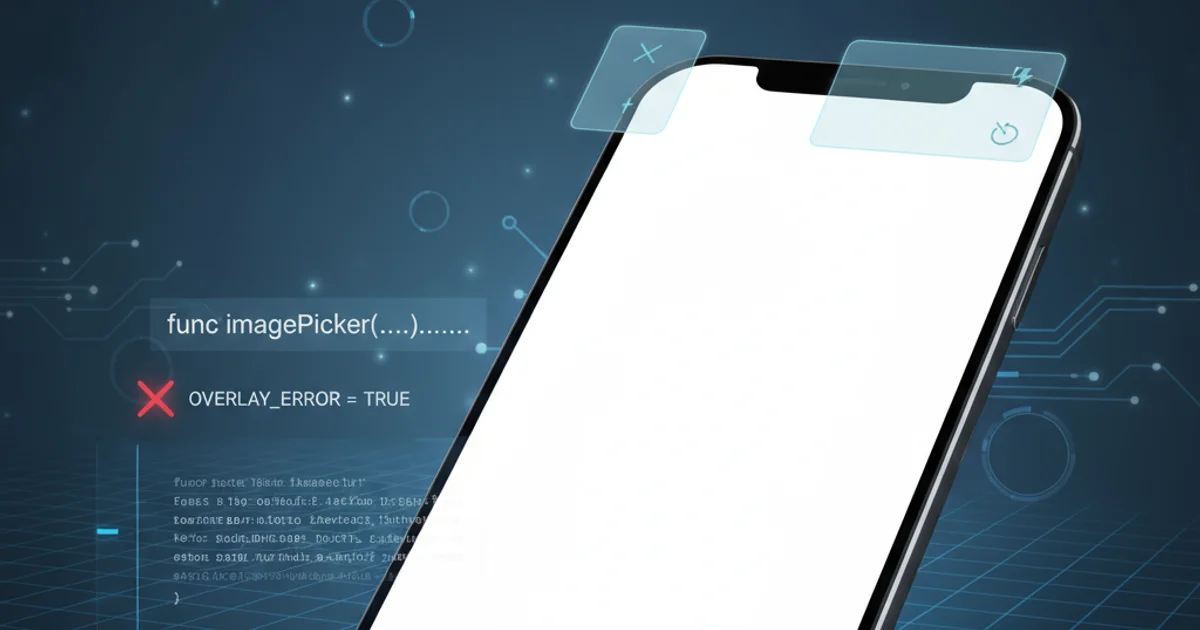Using custom UIImagePicker overlay results in white blank screen camera preview
Categories:
Resolving the White Screen Camera Preview in Custom UIImagePicker Overlays

Learn why your custom UIImagePickerController overlay might be causing a blank white camera preview and how to fix it, especially on iOS 7 and later.
Developing custom camera interfaces using UIImagePickerController in iOS can be a powerful way to enhance user experience. However, a common issue developers encounter, particularly when implementing custom overlays, is the camera preview appearing as a blank white screen. This problem often stems from incorrect view hierarchy management or improper handling of the showsCameraControls and cameraOverlayView properties. This article will delve into the root causes and provide practical solutions to ensure your custom camera overlay functions correctly, displaying the live camera feed as expected.
Understanding the UIImagePickerController View Hierarchy
The UIImagePickerController is a complex view controller that manages its own internal view hierarchy to display the camera feed and default controls. When you introduce a cameraOverlayView, you're essentially placing your custom UI on top of this existing structure. The key to avoiding a blank screen is to understand how these views interact and to ensure that the underlying camera preview view is not inadvertently hidden or removed.
flowchart TD
A[UIImagePickerController] --> B{View Hierarchy}
B --> C[Camera Preview View]
B --> D[Default Camera Controls]
B --> E[Custom Camera Overlay View]
C -- Hidden by default if --> D
D -- Replaced by --> E
E -- Must be transparent to see --> CSimplified view hierarchy of UIImagePickerController with a custom overlay.
A common mistake is to assume that setting cameraOverlayView automatically handles the visibility of the camera preview. While it does replace the default controls, your overlay itself must be configured correctly to allow the camera feed to show through. This primarily involves ensuring your overlay view has a transparent background where the camera feed should be visible.
The Role of showsCameraControls and cameraOverlayView
The showsCameraControls property of UIImagePickerController dictates whether the system's default camera UI (shutter button, flash controls, etc.) is displayed. When you want to use a custom overlay, you typically set showsCameraControls to NO (or false in Swift) and then assign your custom UIView to the cameraOverlayView property. If showsCameraControls remains YES, your custom overlay might still appear, but it will be layered on top of the default controls, potentially leading to unexpected behavior or a partially obscured view.
- (void)presentCamera {
if ([UIImagePickerController isSourceTypeAvailable:UIImagePickerControllerSourceTypeCamera]) {
UIImagePickerController *picker = [[UIImagePickerController alloc] init];
picker.delegate = self;
picker.sourceType = UIImagePickerControllerSourceTypeCamera;
picker.showsCameraControls = NO; // Crucial: Hide default controls
// Create and assign your custom overlay view
UIView *overlayView = [[UIView alloc] initWithFrame:picker.view.bounds];
overlayView.backgroundColor = [UIColor clearColor]; // Ensure transparency
// Add your custom UI elements to overlayView
picker.cameraOverlayView = overlayView;
[self presentViewController:picker animated:YES completion:nil];
} else {
NSLog(@"Camera not available");
}
}
Correctly configuring UIImagePickerController for a custom overlay.
showsCameraControls = NO when using a cameraOverlayView. Failing to do so can lead to unexpected layering issues and prevent your camera preview from being visible.Common Pitfalls and Solutions
Beyond the basic setup, several other factors can contribute to the white screen issue. Understanding these can help you debug and prevent problems.
1. Verify Overlay View Background Color
Ensure that your cameraOverlayView's backgroundColor is set to [UIColor clearColor] or has an alpha value less than 1.0 where you expect the camera feed to show. If your overlay view is opaque, it will completely cover the camera preview.
2. Check Frame and Bounds
Make sure your cameraOverlayView's frame correctly matches the UIImagePickerController's view bounds. Incorrect sizing or positioning can lead to parts of the camera preview being obscured or the overlay not appearing as intended.
3. Delay Overlay Assignment (iOS 7+)
On iOS 7 and later, sometimes assigning the cameraOverlayView immediately after initialization can cause issues. It's often safer to assign it within viewDidAppear or after the UIImagePickerController has been presented. This ensures the internal view hierarchy is fully loaded before you attempt to modify it.
4. Inspect View Hierarchy at Runtime
Use Xcode's View Debugger (Debug -> View Debugging -> Capture View Hierarchy) to inspect the live view hierarchy. This can help you identify if your overlay view is positioned incorrectly, has an opaque background, or if the camera preview view itself is missing or hidden.
// Example of delaying overlay assignment (if necessary)
- (void)viewDidAppear:(BOOL)animated {
[super viewDidAppear:animated];
if (self.imagePicker && !self.imagePicker.cameraOverlayView) {
UIView *overlayView = [[UIView alloc] initWithFrame:self.imagePicker.view.bounds];
overlayView.backgroundColor = [UIColor clearColor];
// Add custom UI elements
self.imagePicker.cameraOverlayView = overlayView;
}
}
Assigning the camera overlay view after the picker has appeared.
UIImagePickerController's view. Always use cameraOverlayView for custom UI elements to prevent conflicts with the picker's internal view management.By carefully managing the showsCameraControls property, ensuring your cameraOverlayView has a transparent background, and being mindful of the timing of overlay assignment, you can successfully implement custom camera interfaces without encountering the dreaded white blank screen.